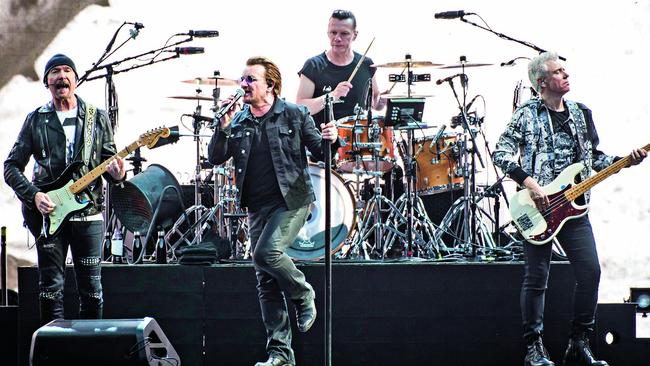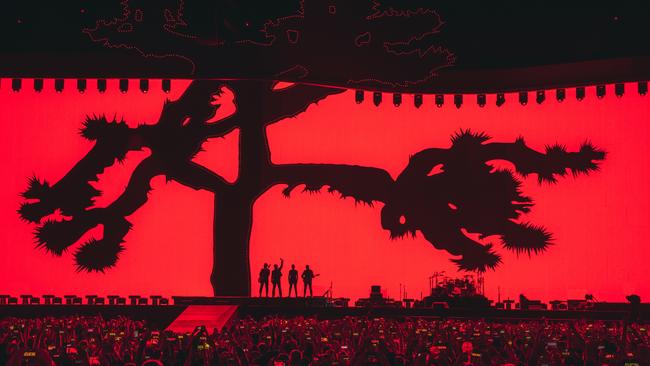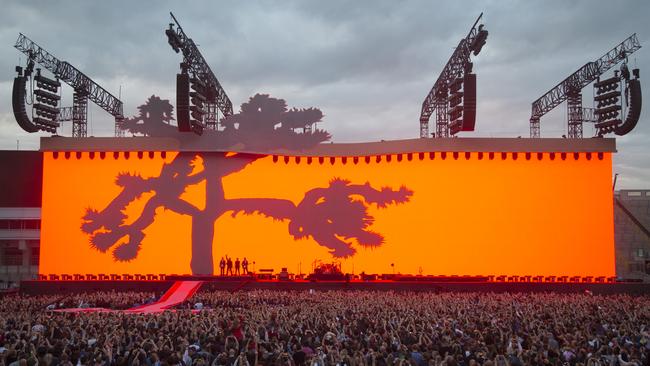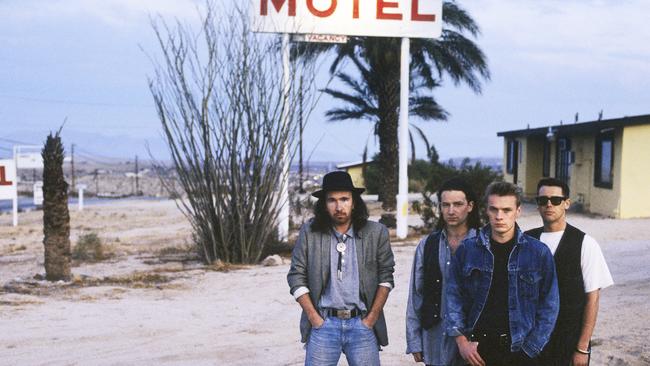The one major thing you won’t see on U2’s Joshua Tree tour
U2’s mammoth Joshua Tree tour is both a musical feast and visual spectacle. But there’s one thing you won’t see when the band takes over a stadium near you this week.

Entertainment
Don't miss out on the headlines from Entertainment. Followed categories will be added to My News.
There is one thing major you won’t see when U2 finally overtake Australian stadiums with The Joshua Tree tour this week.
And that is anything blocking the enormous 61m x 14m screen (the size of four IMAX screens side-by-side) that the band play in front of, projecting new visuals filmed at the national park that gave the album its title.
When U2 launched the tour in 2017 in the US, UK and Europe (to mark the 30th anniversary of the iconic 1987 album) they also launched a new staging technology. Speaker stacks, cables or lighting rigs usually block sightlines — on The Joshua Tree tour all the lighting and sound systems were cantilevered over the video screen from behind on four custom built towers, giving an unobstructed view of the stage and the band.

“There’s no need to have anything block the view of any member of the audience,” says Willie Williams, U2’s longtime stage designer.
”So you see the whole picture. Even though that sounds incredibly obvious, when you see it for the first time — especially if you see a lot of rock concerts — it’s as if your vision has just cleared.”
Williams has worked on every U2 tour since 1982 (as well as with acts from Robbie Williams to George Michael and our own Darren Hayes) including 2009’s 360 tour with the giant claw, the largest stage in rock history (Ed Sheeran just broke that tour’s financial record) – the claw has also just been repurposed at a Utah aquarium.
Work began on The Joshua Tree tour back in 2016, when the concept of the mammoth screen was floated.

The 7.6k resolution screen is the largest and highest resolution of any musical tour to date.
Another U2 lifer, Anton Corbijn, was in charge of the bespoke new visuals – he shot the original artwork for the album that has sold over 25 million copies.
Early on, U2 production manager Jake Berry was insistent about finally getting all the cables and speakers from in front of the screens.
READ MORE:
BEHIND THE SCENES WITH BONO ON TOUR
“We’ve wrestled with it in the past,” Williams says. “On (1997’s) PopMart (tour) we had a screen of similar size, but back in those days the support mechanism (for sound and lighting) had to be there so they chose to make it into a gigantic yellow arch in the spirit of if you can’t hide it make a feature out of it. It’s worth noting the screen on The Joshua Tree tour is one hundred times the resolution of the PopMart screen …”

The 2017 tour, which grossed over half a billion dollars, didn’t just impress fans.
“With U2 we have this in-joke – ‘Tomorrow’s cliches today’,” Williams says. “And now every stadium tour that’s been out since The Joshua Tree tour uses the same trick of putting everything above the screens.
“That’s what’s fun about working with U2. Their ambition isn’t just musical or visually artistic, they really understand the mechanism of how these things work. If there’s an engineering triumph required they’re up for doing it. It doesn’t make for an interesting headline, but it’s part of what makes them unique. They have absolutely lead the way with this tour and now it’s just another industry standard everyone will take for granted.”
The Joshua Tree tour was initially planned as a handful of shows in 2017 to mark the album’s 30th anniversary while the band were plotting their Experience + Innocence tour for 2018.
“Then a few shows became 50 stadiums worldwide,” Williams says after the huge demand for the tour, where The Joshua Tree – their most successful album – is played in full.
It also saw claims — mainly from the legion of U2 haters — that they had finally become a nostalgia act.
“U2 are never going to be nostalgic. It’s just not going to happen. They were never going to show old films of them back in the day. Their default position is to constantly look forward, even when they’re revisiting something from the past.

“They’ve managed to present The Joshua Tree as if it’s their new record. They’re looking at this album through their 21st Century eyes. Even though the presentation is very faithful to the original, it’s a completely new show. Anton went and shot new films, they’re not nostalgic films, they’re about America now. That’s why it works, it doesn’t feel nostalgic.
“Obviously you feel this incredible connection to the music, and the power of the show is to hear this record played by the people who made it. The reason any rock show works is because of what the music has meant to us growing up. Particularly to people the same age as the band. To have these people play you this music now is quite an extraordinary experience. For younger people, they never dreamt they’d get to see U2 play the whole of this record. That’s one level on which the show really works, and it’s far from being a nostalgia trip.”
As soon as The Joshua Tree tour ended in Brazil in October 2017, Australian fans inundated U2 with petitions to get them to bring it down under – they were already horrified when the tour was extended to return to the US for a second leg in 2017.
The last U2 tour of Australia was in 2010 — every other tour since then has bypassed our shores.
The band were already committed to the Experience + Innocence tour for 2018, and radio silence was finally broken when the band announced The Joshua Tree tour would come to Australia – albeit two years late.

It meant getting the entire production out of traction – as well as the stage it includes a huge ‘tree’ that serves as the b-stage – and shipped to the other side of the world (the band also play Singapore, Japan, Korea, India and the Philippines after their Australian and New Zealand dates).
It is the first time they’ve ever returned to a tour long after it has ended.
“We’ve never done a revival before,” Williams says. “The thing with The Joshua Tree tour is they just ran out of year in 2017. They were fully intending to come to Australia at the end of 2017, but they’d already committed to doing the Experience + Innocence tour in 2018, so The Joshua Tree got postponed.”
MORE NEWS:
FAB FOUR REUNITE AFTER RIFT RUMOURS
BEHIND THE SCENES OF U2’S AUSTRALIA TOUR
The band started rehearsals in France two months ago – the show features three sets, one of pre-1987 material, then the album in full in order, followed by a set of hits and other material.
For the past week they have been rehearsing in Auckland — able to move to the venue earlier after Metallica cancelled their tour, which was using the same stadium.
“It’s not so much remembering The Joshua Tree tour that’s been tricky, it’s forgetting the new arrangements (of The Joshua Tree tour songs) that were done for the Experience tour that’s been the tricky part.”

It’s also the first time U2 have ever played a whole album in full for an entire tour, meaning for the first time their fans also know what to expect – at least for one set.
“As the show director, I understand for that section of the show surprise is not on your side. The other side of that coin, because the audience have complete confidence in getting the whole record they relax a lot more. At a normal show with any artist, if they play a lesser known show they might get nervous, let’s wait for one I really love, but when you know the whole thing is going to be played you can savour the whole thing. Even the lesser known songs, it allows the audience to really settle in and enjoy them. And Act three, which is what happens after The Joshua Tree is completely up for grabs.”
THE JOSHUA TREE TOUR:
Suncorp Stadium Brisbane November 12
Marvel Stadium Melbourne November 15
Adelaide Oval November 19
Sydney Cricket Ground November 22-23
Optus Stadium Perth November 27.
Originally published as The one major thing you won’t see on U2’s Joshua Tree tour


